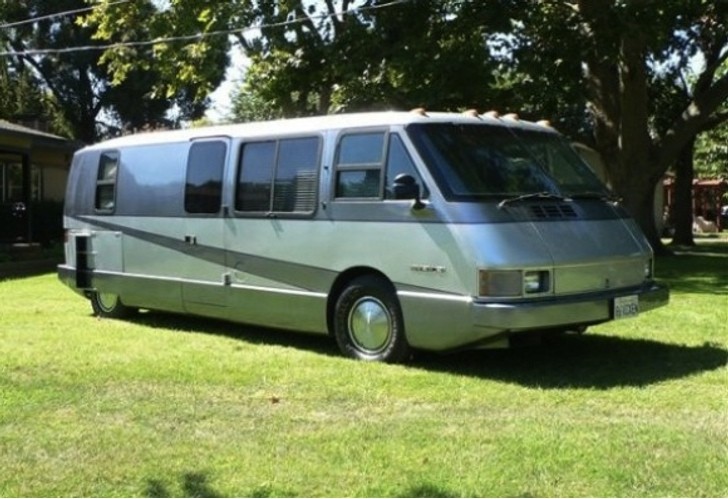Many people are still puzzled about the BMW logo showing up on a people mover, namely the 2 Series Active Tourer. We get the same joy a 3-year-old does when solving a puzzle, so we though we should let these people know the 2 Active Tourer isn’t exactly the first MPV connected to BMW’s name.
In order to do this, we shall travel back in time to the funky 1980s. While the Bavarians were busy with stuff such as launching the first M3 at the time (yes you V8 lovers, it was an L4 that powered the E30 M3), a start-up company in America came up with the Vixen, a recreational vehicle.
Friends liked to call this a “driver’s RV”, simply because, for an RV, it sported an impressively low center of gravity and wide stance. Despite the US’ reluctance to oil burners, the Vixen was powered by a BMW M21 diesel engine. It was even called the Vixed TD.
We are talking about a straight six with a capacity of 2.5 liters, that delivered 114 hp and a peak torque of about 160 lb-ft (220 Nm), depending on the implementation. BMW afficionados are familiar with the engine from the E30 3 Series (324d and 324td), as well as from the E28 and E34 generations of the 5 Series (524d and 524td). As for the transmission, the BMW unit was mated to a five-speed Renault gearbox (transaxle).
The combination between the Bimmer power and a wind tunnel-achieved drag coefficient of under 0.30, meant the Vixen offerd a top speed of 100 mph (160 km/h), while promising to return an average efficiency of 30 mpg (7.8 liters per 100 km).
This RV measured 21 feet (6.4 meters) in length and 6 feet (1.82 meters) in width, its compact size allowing owners to park it in a normal garage.
Heck, if you’re willing to have fun, you can even find a connection between the Vixen and the i3/i8, since the RV could be plugged in. No, the L6 diesel engine didn’t receive electrical assistance, but the thing was gifted with two home batteries and was one of the first vehicles in its class to feature an inverter. Thus, it could be plugged in to at a camping outlet, with the batteries being charged by an 120-amp alternator, allowing the users to enjoy the benefits of its 110-volt outlets.
The story wasn’t all-romantic though, as the company only managed to convince 300 customers over the first two years of production. The public seemed to disagree with the motoring press reviews, which were generally positive.
In an attempt to boost sales, the Vixen was enlarged, while a limo-like model was also released, with this replacing the kitchen and bathroom with extra couches. This was no longer powered by the BMW diesel though, switching to an 165 hp 3.8-liter V6 from GM -ironically, the Vixen had been created as a competitor for the GM Motorhome. Alas, a little under 600 units of the Vixen were sold during its lifetime (1986-1989).
This story is not all retro though - there’s even a website who aims to “take the Vixen into the 21st century”, offering sales support for enthusiasts. Yes, we said "enthusiasts" - we've even heard of folks strapping a GM V8 to the thing.
Friends liked to call this a “driver’s RV”, simply because, for an RV, it sported an impressively low center of gravity and wide stance. Despite the US’ reluctance to oil burners, the Vixen was powered by a BMW M21 diesel engine. It was even called the Vixed TD.
We are talking about a straight six with a capacity of 2.5 liters, that delivered 114 hp and a peak torque of about 160 lb-ft (220 Nm), depending on the implementation. BMW afficionados are familiar with the engine from the E30 3 Series (324d and 324td), as well as from the E28 and E34 generations of the 5 Series (524d and 524td). As for the transmission, the BMW unit was mated to a five-speed Renault gearbox (transaxle).
The combination between the Bimmer power and a wind tunnel-achieved drag coefficient of under 0.30, meant the Vixen offerd a top speed of 100 mph (160 km/h), while promising to return an average efficiency of 30 mpg (7.8 liters per 100 km).
This RV measured 21 feet (6.4 meters) in length and 6 feet (1.82 meters) in width, its compact size allowing owners to park it in a normal garage.
Heck, if you’re willing to have fun, you can even find a connection between the Vixen and the i3/i8, since the RV could be plugged in. No, the L6 diesel engine didn’t receive electrical assistance, but the thing was gifted with two home batteries and was one of the first vehicles in its class to feature an inverter. Thus, it could be plugged in to at a camping outlet, with the batteries being charged by an 120-amp alternator, allowing the users to enjoy the benefits of its 110-volt outlets.
The story wasn’t all-romantic though, as the company only managed to convince 300 customers over the first two years of production. The public seemed to disagree with the motoring press reviews, which were generally positive.
In an attempt to boost sales, the Vixen was enlarged, while a limo-like model was also released, with this replacing the kitchen and bathroom with extra couches. This was no longer powered by the BMW diesel though, switching to an 165 hp 3.8-liter V6 from GM -ironically, the Vixen had been created as a competitor for the GM Motorhome. Alas, a little under 600 units of the Vixen were sold during its lifetime (1986-1989).
This story is not all retro though - there’s even a website who aims to “take the Vixen into the 21st century”, offering sales support for enthusiasts. Yes, we said "enthusiasts" - we've even heard of folks strapping a GM V8 to the thing.












